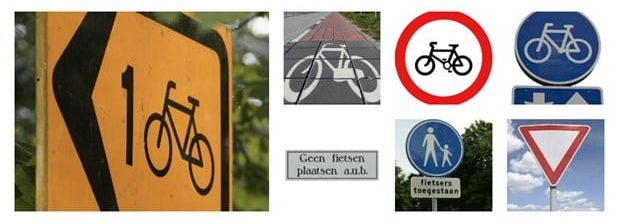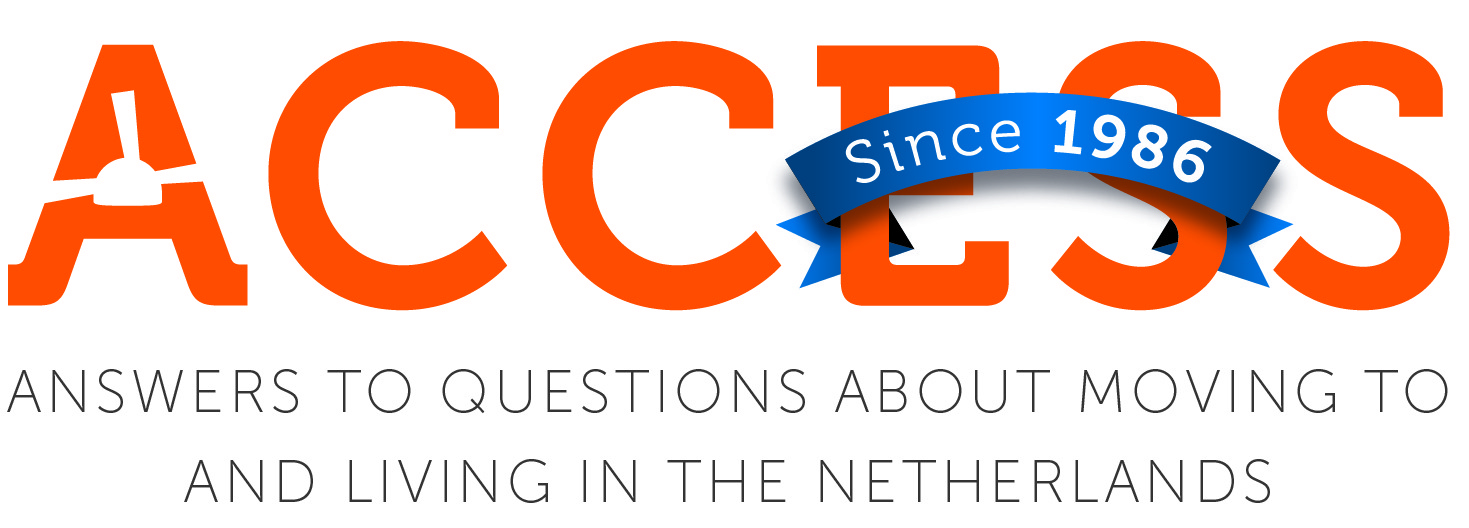ACCESS NL > Relocating to the Netherlands > First three months > Transportation in the Netherlands > Cycling in the Netherlands
Cycling in the Netherlands
Cycling in the Netherlands
Who hasn’t almost been run over by kamikaze tourists poorly navigating on two wheels? While the phrase ‘go with the flow’ may be apt for the experienced ‘fietser’, knowing the rules of the road is a good start. Cycling is so ingrained in the Dutch culture, that children are given bike traffic lessons in grade school in order to get their fiets diploma proving that they know how to be safe while cycling and follow the rules.
The Dutch, undaunted by wind or weather use their bikes all year round.
Traffic signs
You might not speak Dutch, but below list will help you understand the most relevant signs if you are a fietser in the Netherlands:
Fiets = Bicycle
Fietspad(en) = Bicycle lane(s)
Fietsenstalling = Parking for bikes
Geen fietsen plaatsen = Bicycle parking is not permitted (often seen in front of shops)
Fietsers uitgezonderd = This rule does not apply to bicyclists
Fietsen toegestaan = Cycling allowed

Bicycle laws and safety
Usually, drivers and bikers tend to be careful and respect each other’s space in order to ensure everyone’s safety. However, at times the relationship among cars, bikers and pedestrians can become quite conflicting on the Dutch streets,.
“Strict Liability” is supported by Dutch law, and it means that the driver’s insurance is deemed responsible in a collision between a car and a cyclist. But, as a cyclist, it is also important to do your part, so here are some do’s and dont’s when riding your bike.
Do:
Use hand signals when preparing to make a left or right turn. Simply put your arm out in the direction you want to turn so drivers and other bikers can be prepared.
Be prepared for mopeds and faster riding cyclists passing you on the bike path by cycling on the right-side on the lane. Most of the time the brommers (mopeds) must use the main road rather than the bike roads, however in some cases they are allowed on the bike pads. If so, it is explicitly indicated by the blue traffic sign displaying a bicycle and a moped symbol.
Bicycles have bells for a reason! Ring the bell to warn other cyclists that you are approaching them and need to pass them, use it to warn pedestrians who are blocking the bike path, or to warn anyone else who might be in your way. It is better to get an angry look than hurting someone!
Always have white or yellow front and red rear lights on at night. When visibility is poor due to mist, lights are mandatory even during the daytime.
Make sure your bike is equipped. This includes a red rear reflector, reflective pedals, and some sort of side reflector on both wheels or tires. This side reflector should be circular, either a reflective strip on the tire, or one separately attached to the spokes.
Do not:
Cycle on sidewalks and pedestrian-only area.
Cycle on highways!
Park your bike in places that have signs posted saying, Geen fietsen plaatsen (No bike parking.)
Please also find the folder: Road traffic signs and regulations in the Netherlands on the website of Government.nl.
Carrying children on bikes (and some other things)
Beginners might be in awe when they see the many things that Dutch carry on their bicycles. Not only do they transport groceries and pets, but they also carry their children, pieces of furniture and basically anything they need to move around. The Dutch are big on transporting children by bicycle as seen by the number of parents transporting their young ones around town – at times more than one child! But there are laws and safety requirements for cycling with children.
Since 1990 it has been law that only children younger than eight years old can be carried on a bicycle and they must have an effective seat with support for their hands, feet and back. The seat can be attached in front of the parents’ seat or behind it. Besides; children can be transported in a bakfiets or in a so-called fietskar.
Bike thefts
Although the Netherlands is a safe country, bike theft is a big problem. In 2012 450,000 bike bikes were reported stolen. If you come across people on the street asking you if you are interested in purchasing a bicycle, know that these are possibly stolen bicycles.
To help prevent your bike from being stolen, follow these tips:
Park at a guarded bicycle parking lot. Some cities have parking lots where you are presented with a ticket when parking your bike, which must be presented to take your bike out of the parking lot. Train stations often offer parking spaces for bikes that cost a few Euros a day.
Buy a lock for your bike. Most Dutch bikes are equipped with a built-in lock, which locks the back wheel and requires a key to unlock it. But it is advised that you purchase an additional lock to secure your bike onto something. There are bike stands all over the cities, but you can also chain your bike to a post or tree – when allowed. Just be careful not to chain your tire to something because a potential thief will just take your tire off and walk off with the rest of your bike!
Make your bike stand out. Those outrageously decorated bikes that you come across are in that way for a reason. They are painted in bright colours so that they stand out and might discourage potential thieves from stealing them.
Bikes in public transport
If you want to bring your bike on public transport, there are some rules to follow.
Firstly, bikes are not allowed in buses or trams. On the subway in Amsterdam and Rottedam you can take your bike along for free outside of rush hour. However, a maximum of two bikes can be parked on each metro exit.
The RandstadRail allows bikes after 19:00 and on weekends for free.
On trains bicycles are allowed outside of peak hours, (6:30-9:30 and 16:30-18:00), Monday through Friday – except in July and August. A Dagkaart Fiets (Bike Day Ticket) costs €6, but taking a folded bicycle on the train is free.
Bicycles must be placed in a special bike area on the train, which can be recognised by a sticker of a bicycle on the outside of the train.
Other important information
If you cannot ride a bike, there are several places that offer lessons. In case you need to have your bike repaired, Rijwielhandels (bike shops) are readily available and it is easy to obtain spare parts and/or have your bike repaired. You can also find online professionals who come to your house to get your bike repaired.
If you want to know more about cycling routes, maps are widely available and come in two forms: Route Maps and National Maps. A Route Map is a national map that shows route information rather than general topography. Only the routes are marked and related information is shown. They are often used for holidays and sold at most tourist shops. National Maps cover the entire country, with markings and symbols about the cycle ways of the Netherlands. They are very useful not only for cycling in unfamiliar towns and cities but also for cross-country use. These are sometimes expensive but are larger and are widely available at tourist shops.
Suggestion: go to the tourist office (VVV) for information and advice about cycle routes, whether it is in your own town or in another area of the Netherlands.
Cycle routes can be found on the internet as well. If you search on cycling routes Netherlands you find many useful websites. You can also add the name of the town where you want to start e.g cycling routes The Hague or cycling routes Utrecht. Then you find cycle routes in the area you want to cycle.
You will find more useful information about cycling in the Netherlands in our ACCESS guide ‘Your First three Months in the Netherlands’.


